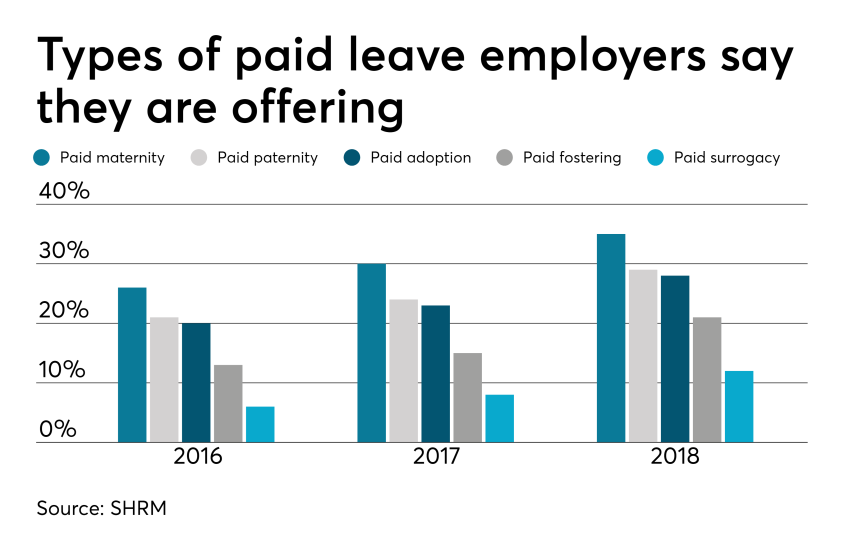How to prevent employees from taking advantage of unlimited PTO
Attracting and retaining is becoming more difficult. Because of this companies are now offering competitive benefits to bring that talent to their company. Companies have added unlimited paid time off, along with work from home policies to their benefits offering. Read this blog post to learn how to prevent employees from taking advantage of new benefits being put in place.
In the quest to attract and retain top talent, more companies are offering competitive benefits including unlimited paid time off and generous work from home policies. But what if you have workers who abuse the policy?
To prevent workers from taking advantage, it’s critical that companies set proper guidelines, says Jonathan Wasserstrum, CEO and founder of Squarefoot, a commercial real estate company, which offers its staff unlimited personal time off. At his company, people were utilizing the policy from “all ends of the spectrum,” which led him to reassess how they monitored and encouraged time off.
“The war for talent is so strong right now, and when an employee is looking to make a decision, you don’t want to disqualify yourself because you don’t offer this benefit,” he says. “But people don’t use the amount of vacation days intended. You get some people who underutilize and over utilize. The bad spoils the good, and that's not the intent of unlimited policy.”
Unlimited paid time off is becoming a more popular benefit, especially in the tech space. According to Indeed, 65% of companies mentioned “unlimited PTO” in their job postings, and companies like General Electric and Kronos offer the benefit to employees.
While the standard time off has typically been two to four weeks, 55% of employees do not use all of their paid time off, according to the U.S. Travel Association. To level the playing field among his employees, Wasserstrum says he established guidelines that made unlimited PTO flexible, but still within reason.
“There are top performers who work a lot, and you don't want them to burn out. On the other end of the spectrum, there are those who take advantage of policy,” he says. “We frame it as flexible and not unlimited. The intent is for everyone to use it as time away from the office — it helps you refresh — so we encourage you to take anywhere from two to four weeks.”
Paid time off has a multitude of benefits, including increased employee morale and a better sense of work-life balance. And today’s workforce is in desperate need of time away from the office. According to Deloitte, 77% of employees say they have experienced burnout, and 70% say their employer does not do enough to prevent or mitigate work stress.
“Work-life balance looks very different now than it used to,” Wasserstrum says. “If I'm on vacation 20 years ago, you really can't get in touch with me. Now, everyone is 24/7 on, so you have to set the boundaries as an employer.”
In addition to more paid time off, more people are also reaping the benefits of remote work. According to a Gallup poll, 43% of the workforce works remotely some or all of the time, but employers like IBM, Aetna and Yahoo have pulled back on those policies and required workers to be on site instead, according to the Society of Human Resource Managers.
"[Managers] may have realized how blind and invisible remote workers are and they don't know what's going on at the remote location — what work that person is doing or what distractions they may have to deal with,” Judith Olson, a distance-work expert and professor at the University of California Irvine, told SHRM.
With more employees weighing the benefits of workplace policies, time off is still the top benefit employees look for. Metlife found 72% named unlimited paid time off as their most desired benefit, ahead of wellness plans and retirement programs.
While it may put companies at an advantage, PTO and other flexible work policies are just one part of the overall picture of a company’s workplace culture, Wasserstrum says.
“If you're winning people based on benefits, they're coming to you for the wrong reasons,” he says. “But every company looks and feels different from the inside and has a company culture that shouldn’t be one size fits all. This works for us and the work-life balance experience we want people to have.”
SOURCE: Place, A. (17 Decemeber 2019) "How to prevent employees from taking advantage of unlimited PTO" (Web Blog Post). Retrieved from https://www.benefitnews.com/news/how-to-prevent-employees-from-taking-advantage-of-unlimited-pto
4 pitfalls of paid leave and how clients can avoid them
Employers are using paid leave options to help boost their employee benefits packages in efforts to better attract and retain talent. Read the following blog post from Employee Benefit Advisor for 4 common pitfalls of paid leave and how employers can avoid them.
 Smart employers are boosting their benefits packages with paid family leave — the most coveted work perk among all generations. In today’s low unemployment environment, paid leave benefits can be a huge differentiator in attracting and retaining talent.
Smart employers are boosting their benefits packages with paid family leave — the most coveted work perk among all generations. In today’s low unemployment environment, paid leave benefits can be a huge differentiator in attracting and retaining talent.
But some employers are getting themselves into trouble in the process, facing accusations of gender discrimination or improper use of leave.
Here are four potential pitfalls of paid leave, and how employers can avoid them.
1. Be careful what you call “maternity leave.”
Employers have long been granting leave for new moms in the form of disability coverage. In fact, the top cause of short term disability is pregnancy. Disability insurance usually grants new moms six to eight weeks of paid leave to recover from childbirth.
Because this coverage applies to the medical condition of recovering from childbirth, it shouldn’t be lumped in with bonding leave.
Guidance from the Equal Employment Opportunity Commission says leave granted for new moms for bonding must also be extended to new dads, so separating disability leave from bonding leave is crucial to avoiding gender discrimination.
2. Don’t make gender assumptions.
The amount of bonding time for new parents after birth, adoption or fostering must be granted equally for men and women. Companies that don’t provide the same amount of paid leave for men and women may find themselves in a discrimination lawsuit.
It’s not just the time away from work that matters, but also the return-to-work support provided. If new moms are granted temporary or modified work schedules to ease the transition back to work, new dads must also have access to this.
Some companies may choose to differentiate the amount of leave and return-to-work support for primary or secondary caregivers. That’s compliant as long as assumptions aren’t made on which gender is the primary or secondary caregiver.
The best way to avoid potential gender discrimination pitfalls is to keep all parental bonding and related return-to-work policies gender neutral.
3. Avoid assuming the length of disability.
Be careful about assuming the length of time a new mom is disabled, or recovering medically, after birth. Typical coverage policies allot six to eight weeks of recovery for a normal pregnancy, so assuming a new mom may be out for 10 weeks might be overestimating the medical recovery time, and under-representing the bonding time, which must be gender neutral.
4. Keep up with federal, state and local laws.
Mandated leave laws are ever-evolving, so employers should consistently cross-check their policies with state and local laws. For instance, do local paid leave laws treat adoption the same as birth? Are multistate employers compliant? What if an employee lives in one state but works in another: Which state’s leave policies take precedence?
Partnering with a paid leave service provider can mitigate the risk of improperly administering leave. Paid leave experts can help answer questions, review guidelines and provide information regarding job-protecting medical or family leave.
They can also help flag potential pitfalls, ensuring leave requests from all areas of your company are managed uniformly and in accordance with state and federal laws, including the EEOC.
SOURCE: Bennett, A. (12 September 2019) "4 pitfalls of paid leave and how clients can avoid them" (Web Blog Post). Retrieved from https://www.employeebenefitadviser.com/list/4-pitfalls-of-paid-leave-and-how-clients-can-avoid-them
Netflix exec: To boost diversity, employers must improve benefits
Are you implementing specific employee benefits in an effort to boost diversity and inclusion at work? According to Vice President of Inclusion Strategy at Netflix, Verna Myers, Implementing the right employee benefits could help employers boost workplace diversity and inclusion.
NEW YORK — Employers still have a long way to go when it comes to fostering diversity and inclusion at work — but implementing the right benefits could be a step in a positive direction.
That’s according to Vernā Myers, vice president of inclusion strategy at Netflix, who said companies should focus on rolling out new benefits that help employees at different life stages. While perks like free lunch are nice, they aren’t going to keep workers around long term, she said at a meeting with reporters Wednesday.
“It’s more about [having] a kind of system that acknowledges real life and what people’s needs are,” she said. “That builds a certain kind of loyalty and trust.”
So what should employers focus on? Myers said employees want holistic benefits that address life changes, including starting out careers and parenthood. Mental health and financial benefits also should be a priority.
So far, tech companies, startups and other progressive employers are doing this well. “Companies have realized they’re part of a life ecosystem, and that makes a big difference,” she added.
But employers may still have a long way to go. Myers, who is a Harvard trained lawyer, said she has heard of instances where male employees faced discrimination for taking advantage of benefits like paternity leave. Meanwhile, offerings like maternity leave have not always been industry standard, she said.
“People still don’t remember that we did not have maternity leave,” Myers said, recalling a conversation with a partner at a law firm who used three weeks of vacation time when she had her baby.
Myers said she has overwhelmingly found that while organizations are interested in bringing in more diverse workers, they often won’t make adjustments to benefits and culture in order to better accommodate these employees. Employers “were unwilling to do much of anything to adjust to the fact that they were inviting difference,” she said.
Survey data from PwC suggests that diversity and inclusion is a high priority for employers, but many can still do more to improve their programs. A full 74% of employers said diversity and inclusion is a priority at their company. But the consulting firm found that only 5% of the programs were reaching their full maturity when assessed against PwC’s model, which reviews factors including strategy and engagement.
But employers have shown interest in adding more inclusive benefits. Some — like Hewlett Packard Enterprise and Hilton — have invested in family-friendly offerings like expanded paid parental leave and breast milk shipping. Others are adding student loan repayment programs and coaching benefits.
Susan Eandi, the head of Baker McKenzie’s global employment and labor law practice in North America, said employers need to focus on employee engagement in benefits if they want to improve diversity and inclusion. As Generation Z enters the workforce, companies may see a shift toward stability. Unlike their millennial counterparts, who spearheaded flexible schedules and gig work, Gen Z workers are more cautious and want security in their jobs and benefits.
“They’re very cautious, concerned individuals who want financial security,” she said. “It will be a big shift for employers.”
Regardless, Myers said companies should continue to create safe spaces for all perspectives and backgrounds to influence decision making. “If employers allow for more opportunity and for people be treated more fairly, then everyone is going to benefit,” she said.
SOURCE: Hroncich, C. (15 May 2019) "Netflix exec: To boost diversity, employers must improve benefits" (Web Blog Post). Retrieved from https://www.benefitnews.com/news/netflix-to-boost-diversity-employers-must-improve-benefits



